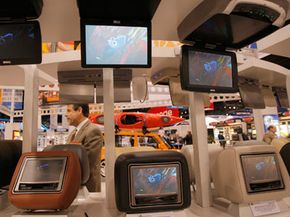In-car video entertainment. For those of us who spent our childhood on road trips, crammed in the back of a station wagon with nothing to do but punch our brothers or sisters, it seems like a godsend. For the parents who were trapped in the same car with three kids who decided to pass the time by punching, pinching and asking, "Are we there yet?" it seems like nirvana. But for today's kids, it's becoming par for the course.
With technology shrinking, drivers are no longer dependent on their radios to entertain passengers. Cars and trucks can now be outfitted with VCRs, DVD players and even the latest video game systems. While the entertainment systems' range includes everything from basic portable DVD players to large ceiling-mounted viewing screens, the most luxurious viewing option for many car passengers is headrest monitors. With headrest monitors, each passenger has a personal monitor mounted on the back of the headrest of the seat directly in front of them. Not only do personal monitors of this sort cut down on issues like sun glare, but in some systems, each monitor can display different programming (ending fights over what to watch) or even use different entertainment devices. That means that while one passenger watches a DVD, another can play video games.
Advertisement
Of course, there are some downsides to built-in headrest monitors.
The systems tend to be very expensive. While some manufacturers offer the systems straight from the factory, they can add thousands of dollars to the price of a car. Actually, only a few luxury car manufacturers currently offer factory-installed headrest monitors -- making them an expensive addition to an already expensive purchase. Aftermarket headrest monitors are more common, but these are still an expensive proposition and usually require professional installation.
But, if it's headrest monitors you want, we've got you covered. So buckle up, quit bothering your sister and if you ask to stop at McDonald's one more time, we're turning this HowStuffWorks.com article right around and no one will learn anything about headrest monitors. So be good, and go to the next page to learn about the different types of headrest monitors.
Advertisement





